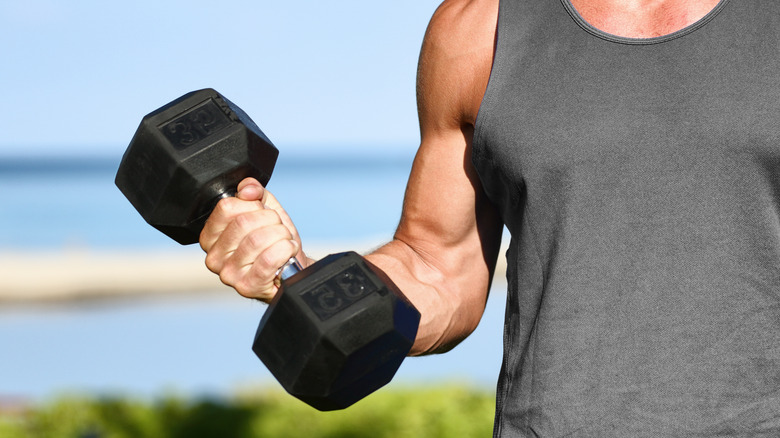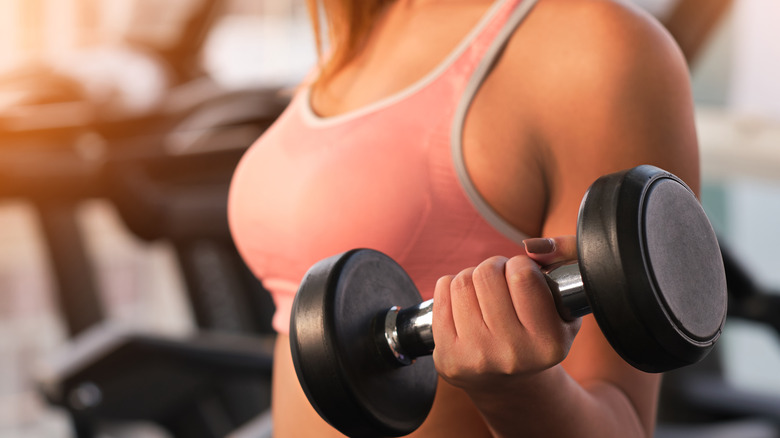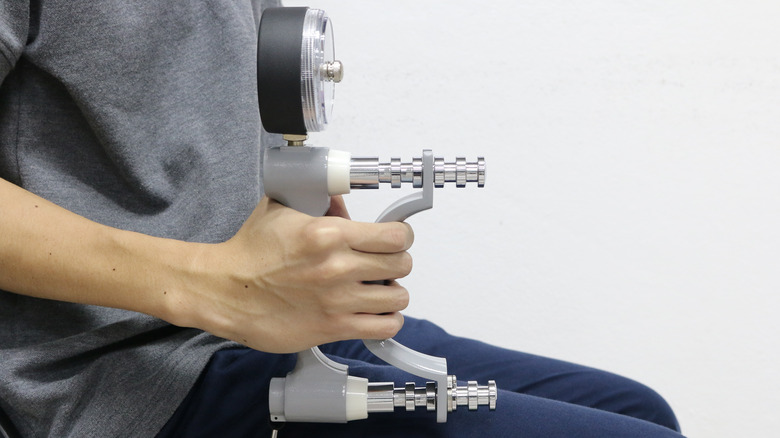What Happens To Your Body When You Do Arm Workouts Every Day
Typically, workout programs split workouts between muscle groups and allow for rest time between workouts. For example, the American College of Sports Medicine recommends working every major muscle group 2-3 times per week. In each weight training workout, they recommend 8 to 10 exercises. Each exercise should be performed for 2-3 sets, with 8-12 reps each set.
Standard recommendations such as these from the American College of Sports Medicine are helpful for many fitness enthusiasts, particularly beginners. However, if you've been training your arms every day and are frustrated by a lack of progress, you can change your approach. You can try mixing up the numbers of days you work out, as well as the number of sets and reps you do. Training every day is an option, although it's intense. You can grow your muscles faster and benefit from consistent exercise in other ways. Your mental and physical health both improve when you work out often.
That said, what happens if you were to do workouts focused on a single body part every day? Specifically, what if you were to do arm workouts daily? Here's how that would affect your body.
You'll get bigger arm muscles
Tracking your progress in the gym can be tricky, but one metric is useful for people who want to grow their muscles. Training volume, according to a study published in Medicine and Science in Sports and Exercise, is the best predictor of muscle growth. You can calculate your training volume for each exercise by multiplying the number of sets, reps, and the amount of weight together. For example, if you do a bicep curl with 10-pound dumbbells for 3 sets of 10 reps, that's 300 pounds of volume.
Working your arms every day increases your training volume very quickly. You can increase your volume by adding another set to your workout. Using the bicep curl example, performing 4 sets instead of 3 gives you 400 pounds of volume. Adding another day per week of the same exercise doubles your volume. Adding more volume to your workouts helps you build muscle faster, and can be particularly useful if your progress is slowing.
You'll get stronger arms
If you're more worried about the strength of your muscles than their size, training your arms every day can still help.
While it primarily helps with growing muscle, increasing your training volume also makes you stronger. A study published in Physiological Reports showed that increasing training volume helped muscles grow and get stronger, but it wasn't the best way to increase strength. Using heavier weights was more important than increasing workout volume when it came to increasing strength.
To get stronger, you can simply shift your focus in each workout to be more strength-based. Your volume will be increasing simply because you're working out more often, but you can tweak each workout by lowering the number of sets and/or reps you do for each exercise. At the same time, you should increase the weight you use slightly to keep the exercises challenging. Even if you don't, you'll continue getting stronger as your muscles grow bigger.
You'll have a stronger grip
Bigger forearm muscles complement bigger arm muscles, and you can grow both if you work your arms every day. You'll also have more grip strength. Not only will that aid you with whichever arm exercise you choose, a stronger grip also translates to other exercises like deadlifts or pull-ups. The stronger your grip is, the more weight you can handle in grip-intensive exercises.
While you can choose to target the large grip muscles that run up your forearm, you can simply work your arm muscles and improve your grip strength as an added bonus. A study published in Isokinetics and Exercise Science tested this theory by having a group of subjects perform multiple upper-body exercises. They found that even a general program targeting the upper body was enough to improve grip strength. Working your arms every day should translate into added grip strength and larger forearm muscles, even if that's not your main goal.
You'll get better at sports
Athletes can boost their performance by training their arms consistently. Stronger, more muscular arms can be useful in sports that require a stronger upper body. Even tennis players, who you might not associate with strong arm muscles, can benefit from daily arm workouts. A study published in the Budapest International Research and Critics in Linguistics and Education Journal found that players who had stronger grips were able to serve more accurately. The study shows that hand dexterity is improved by strength training.
Not all athletes will benefit from strengthening their arms, though. Soccer players, for example, use little arm strength and primarily count on their legs to do the work. Keep in mind that playing a sport and lifting weights every day can result in an overuse injury such as tendinitis. If you experience pain in your shoulder, elbow, or wrist, that could be why. Be sure to slowly integrate weight training or your sport back into your routine to see how it affects your body.
You'll burn more calories
Every workout you do burns calories. While an arm workout might not seem like a major calorie-burner compared to running or lower-body workouts, doing them every day can make a difference.
A study published in the Journal of Strength and Conditioning Research found that subjects who lifted weights burned between 70 and 289 calories per session. The difference depends on factors like age, weight, gender, and the intensity of the workouts.
In the study, the researchers note that more calories are burned after the workout as well. Researchers can tell that your body is burning calories after a workout by measuring something called post-exercise oxygen consumption, which measures how much oxygen your body uses after your workout compared to before. If you use more oxygen, that means your body is burning energy. The researchers also note that lifting weights can boost your metabolism, meaning you burn more calories in the long run.
You'll get stress relief
Lifting weights seems stressful, and in the moment, it is. You should be excited and motivated to do each exercise to the best of your ability. That's a good form of stress, as that prepares your body to do work. However, constant stress can be harmful for the body. One way to combat this stress can be by working your arms every day in the gym.
A paper published in Frontiers in Psychology investigated the effect of lifting weights on stress. The researchers had subjects perform exercises at different intensities. They found that the group of people that performed low-to-moderate intensity weight training was the best for reducing anxiety. If you work out everyday, you don't need to do very intense exercises. You can perform low- to moderate-intensity workouts and continue to make progress because you're exercising so much. The stress-relieving benefits of lifting weights were observed across a wide variety of people, according to the researchers, which means that it's probably helpful for most people.
Your risk for cardiovascular disease will go down
There are multiple factors that contribute to your risk for developing cardiovascular disease. Some are out of your control, such as age and family history of heart disease. Others, such as exercise, are in your control. The Centers for Disease Control and Prevention (CDC) recommends at least 150 minutes of moderate-intensity aerobic exercise to reduce your risk for heart disease. Aerobic exercise is endurance training such as running, cycling, swimming, or walking.
While aerobic exercise is often recommended for heart health, resistance training can also reduce your risk for heart disease. A study published in the Journal of Science and Medicine in Sports found that women who lifted weights reduce their risk for developing cardiovascular disease without performing aerobic exercise. Training your arms every day for 30 minutes will give you 210 minutes of activity per week. For someone concerned about cardiovascular disease, daily arm workouts could be helpful.
You'll reduce your risk of developing type 2 diabetes
Those suffering from diabetes need ways to control their blood sugar. Medication can be very effective, but you might be looking for other ways to stay healthy and control your sugar levels. Diabetics benefit from regular physical activity, says the CDC. They even say that less than the recommended 150 minutes per week of activity can benefit someone with diabetes. More exercise is even more helpful.
While aerobic exercise is helpful for reducing one's risk for diabetes, resistance training is equally as effective. In fact, a study published in Sports Medicine showed that regular resistance training reduced the risk of developing type 2 diabetes as much as changes in diet. While you should strive to maintain a healthy diet, this study shows the power of resistance training for preventing type 2 diabetes. Note that the researchers in this study weren't investigating the effects of weight training on people with diabetes — they were looking at ways to reduce the risk of developing diabetes.
You'll have a reduced risk for injury
Lifting weights makes your muscles stronger, but it also strengthens your bones, tendons, and ligaments. Your arms will be more resilient if you lift weights every day.
When you lift weights, your bones get stronger and more resistant to injury. You're also less likely to develop osteoporosis if you consistently lift weights (per the American College of Sports Medicine's Health and Fitness Journal). Additionally, resistance training is even more effective that impact exercises such as jumping and running.
Tendons are the thick bands of tissue that connect your muscles to bone, while ligaments connect bones to other bones. When you lift weights, your tendons and ligaments grow thicker and stronger. That means you're less likely to suffer from tendon and ligament injuries. The increases in size and strength are proportional to the amount of muscle you build, meaning you can simply focus on building muscle and your tendons and ligaments will grow as well.
You'll burn body fat
Lifting weights helps burn calories, which in turn helps burn body fat. Fat stores energy in the body and releases it when you need it. Regular exercise, such as daily arm exercises, burns calories and raises the total amount of energy you burn in a day. To lose fat, you need to burn more calories than you take in. This is known as energy balance, which measures how much energy comes into the body versus how much goes out (via the European Food Information Council).
Aerobic activities like running, cycling, and swimming are typically used for burning fat, while weight training is known for building muscle and strength. However, a study published in Sports Medicine showed that people who trained with weights also lost body fat. That means doing arm exercises consistently can help you burn fat not only in your arms, but in the rest of your body as well. The researchers even found a decrease in visceral fat, which is the fat around your organs.
You'll decrease your LDL cholesterol
Low-density lipoproteins are a vessel that carries cholesterol from the liver into the bloodstream and through your body. LDL cholesterol, which is the name for low-density lipoproteins bound to cholesterol, is harmful if there's too much in the body. An excess in LDL can increase your risk for developing heart disease by clogging arteries and restricting bloodflow, says the Cleveland Clinic.
Working your arms every day can help lower your risk for developing high levels of LDL cholesterol, and in turn reduce your risk for heart disease and stroke. A study published in Diabetology and Metabolic Syndrome showed that people who participated in regular resistance exercise reduced their LDL cholesterol levels. The researchers point out that the key was that these people lifted weights consistently over time. Performing arm exercises daily will keep your consistency high. Those with high or borderline high LDL cholesterol levels should consider doing arm exercises every day.
Your HDL cholesterol will increase
While LDL cholesterol is bad, HDL cholesterol is good and can even lower your LDL levels. HDL cholesterol takes free-floating cholesterol out of the bloodstream and delivers it back to the liver, where it can be expelled from the body.
HDL stands for high-density lipoprotein, which is a substance that binds with cholesterol to form HDL cholesterol. If your doctor finds that your HDL levels are too low, they can suggest exercise as a way to boost them.
Daily arm workouts should lift your HDL cholesterol levels while lowering your LDL cholesterol levels. A study published in Diabetology and Metabolic Syndrome found that people who performed vigorous weight training had elevated HDL cholesterol levels for 24 hours after their training session. If you do a workout every day, your levels should remain elevated, although the researchers didn't investigate that specifically. Moreover, raising your HDL and lowering your LDL cholesterol can reduce your risk for developing heart disease (via WebMD).
You'll improve your push-ups
Arm exercises focus on two main muscles: the biceps and the triceps. Your biceps run down the front of your arm from the shoulder to the elbow, while the triceps run down the back of your arm from your shoulder to the elbow. The triceps extend the elbow, which means that they straighten the elbow when it's bent. Triceps pushdowns and triceps extensions are commonly used exercises because they work the muscles directly.
Other movements use the triceps, including push-ups and bench presses. A study published in Shoulder and Elbow examined which muscles work the most in different push-up variations. Unsurprisingly, they found that the chest muscle is the biggest contributor. Behind the chest muscles were the triceps. In four of the six exercises the researchers tested, the triceps were second in terms of importance behind the chest muscles. In other words, if you train your triceps every day, they'll get stronger, which can have beneficial effects on your push-ups.
Your chin-ups will improve
Many variations of biceps curls can be used to keep things fresh when you're doing arm workouts every day. The biceps bend the elbow, as opposed to the triceps (which extend it). Stronger biceps mean you can curl more weight, but that strength carries over to other exercises as well. Your triceps are used in pushing motions like push-ups and bench presses, while the biceps are used in pulling motions. Rows, pulldowns, and chin-ups are all considered pulling motions.
Working your biceps every day will make them stronger, which can make you better at exercises that involve the biceps like the pull-up. A study published in the Journal of Strength and Conditioning Research found that during a pull-up, the biceps were one of the most-used muscles. At the bottom of the pull-up, when the movement is initiated, they weren't very active. However, towards the top, they became more active and helped at the very top of the motion (when you need to get your chin over the bar). The researchers saw that the biceps muscle was activated to between 78% and 96% of its maximum potential.















